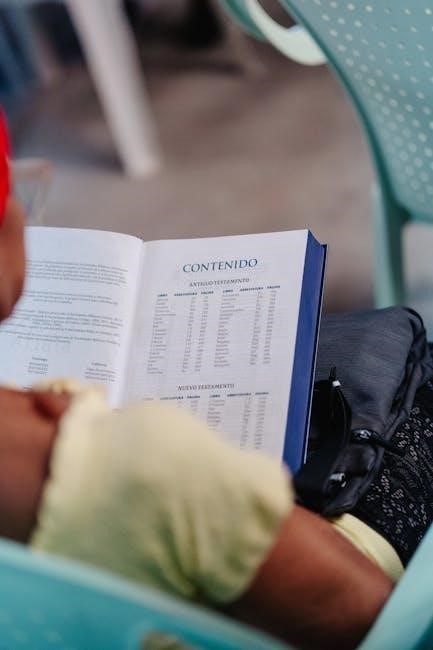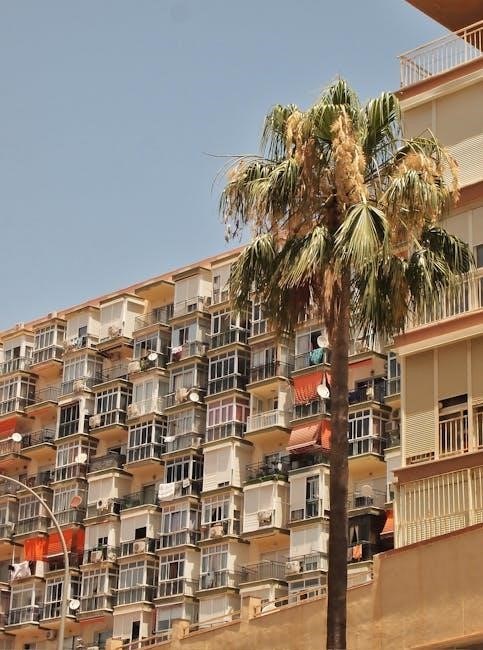
A free rental agreement in Spanish PDF is a legally binding document essential for outlining terms between landlords and tenants. It ensures clarity, protects both parties, and simplifies negotiations.
1.1 What is a Rental Agreement?
A rental agreement is a legal contract between a landlord and tenant that outlines the terms and conditions for renting a property. It typically includes property details, rental duration, payment terms, and responsibilities of both parties. This document ensures clarity and protection for all involved, serving as a reference for resolving disputes. In Spain, such agreements must comply with local laws and are often provided in Spanish for legal validity, making free PDF templates a practical solution for both landlords and tenants.
1.2 Importance of Having a Written Rental Agreement
A written rental agreement is crucial for establishing a clear understanding between landlords and tenants. It prevents disputes by outlining responsibilities, payment terms, and property conditions. The document serves as legal evidence, protecting both parties’ rights and ensuring compliance with Spanish rental laws, such as Ley 29/1994. Having a formal agreement fosters transparency and accountability, making it easier to resolve conflicts and maintain a harmonious rental relationship. It is a safeguard for both parties, ensuring all terms are mutually agreed upon and legally binding.
1.3 Why Use a Free Rental Agreement Template in Spanish?
Using a free rental agreement template in Spanish offers numerous advantages. It provides a cost-effective solution for landlords and tenants, saving time and resources. These templates are designed to comply with Spanish rental laws, ensuring legal validity. They also allow for customization to fit specific needs, such as property details and payment terms. Additionally, free templates are easily accessible online, making it convenient to create a formal and binding agreement without the need for legal drafting expertise. This practical tool simplifies the rental process while maintaining professionalism and clarity.

Benefits of Using a Free Rental Agreement Template
A free rental agreement template in Spanish offers cost savings, time efficiency, and legal compliance. It provides a structured format, ensuring all essential terms are included, and reduces drafting efforts, making it accessible to both landlords and tenants without legal expertise. Additionally, it allows for easy customization to suit specific rental scenarios, promoting clarity and professionalism in the agreement process while adhering to Spanish rental laws and regulations.
2.1 Cost-Effective Solution for Landlords and Tenants
A free rental agreement template in Spanish is a budget-friendly option for both landlords and tenants. It eliminates the need for expensive legal fees, offering a ready-to-use document that can be downloaded in PDF or Word format. This accessibility ensures that neither party incurs additional costs, making it an ideal choice for individuals and small property managers. The template’s affordability allows landlords and tenants to focus on the rental terms without financial strain, promoting a fair and transparent agreement process while maintaining legal compliance.
2.2 Time-Saving Alternative to Custom Legal Documents
Using a free rental agreement template in Spanish saves significant time compared to drafting a custom legal document. These templates are readily available in PDF or Word formats, allowing landlords and tenants to quickly fill in personal and property details. They are designed to be comprehensive, covering essential clauses like property description, payment terms, and tenant responsibilities. This eliminates the need to create a document from scratch, ensuring a fast and efficient process while maintaining legal compliance. It’s an ideal solution for those seeking a hassle-free rental agreement setup.
2.3 Ensures Compliance with Spanish Rental Laws
A free rental agreement template in Spanish ensures compliance with local laws, such as the Urban Leasing Law (Ley 29/1994). These templates are designed to include mandatory clauses and adhere to regional legal variations. By using a verified template, landlords and tenants can avoid legal disputes and ensure the agreement is enforceable. This compliance protects both parties’ rights and obligations, making the rental process smoother and more secure. It’s a reliable way to meet legal requirements without drafting a custom document.

Where to Find Free Rental Agreement Templates in Spanish
Free Spanish rental agreement templates are available on official government websites, legal document platforms, real estate sites, and open-source repositories, ensuring easy access for all users.
3.1 Official Government Websites
Official government websites in Spain, such as the Boletín Oficial del Estado (BOE), provide free rental agreement templates in Spanish. These templates are designed to comply with Urban Leasing Law (Ley 29/1994) and regional variations. They often include essential clauses like property descriptions, rental terms, payment details, and termination conditions. Using these templates ensures legal compliance and saves time. They are easily downloadable in PDF or Word formats, making them accessible for landlords and tenants. Government-backed templates are reliable and legally sound, offering a cost-effective solution for creating rental agreements.
3.2 Legal Document Websites
Legal document websites offer a variety of free rental agreement templates in Spanish, ensuring compliance with local laws. These platforms provide customizable templates that cover essential clauses like property descriptions, rental terms, and payment details. They are designed to be user-friendly, allowing landlords and tenants to download and print agreements easily. Many legal document websites also offer guides and resources to help users understand and fill out the templates correctly. This makes them a reliable and efficient option for creating legally binding rental agreements without legal fees.
3.3 Real Estate Platforms
Real estate platforms like Idealista or Fotocasa often provide free rental agreement templates in Spanish. These platforms cater to landlords and tenants, offering downloadable PDF formats that simplify the rental process. The templates are designed to be user-friendly, covering essential sections such as property details, rental duration, and payment terms. Many platforms also include guides to help users understand legal requirements and customize the agreement according to their needs. This makes real estate websites a practical resource for creating legally valid rental contracts efficiently and without additional costs.
3.4 Open-Source Legal Template Repositories
Open-source legal template repositories offer free access to rental agreement templates in Spanish PDF format. Websites like LegalZoom or Rocket Lawyer provide downloadable documents that cater to various rental scenarios. These templates are designed to be customizable, ensuring users can adapt them to specific needs while maintaining legal compliance. Many repositories update their templates regularly to reflect changes in rental laws, making them a reliable and cost-effective solution for landlords and tenants seeking professional-grade agreements without legal fees.

Key Components of a Spanish Rental Agreement
A Spanish rental agreement must include property description, rental terms, payment details, deposit clauses, tenant responsibilities, landlord obligations, and termination conditions to ensure legal validity and clarity.
4.1 Property Description
The property description in a Spanish rental agreement details the address, type, and condition of the rental property. It includes the number of bedrooms, bathrooms, and any shared or private spaces. This section also outlines amenities like parking, balconies, or elevators. Accurate property description ensures both parties agree on the rental property’s condition and features, preventing future disputes. It is essential to include specific details to avoid misunderstandings and ensure clarity in the agreement.
4.2 Rental Terms and Conditions
Rental terms and conditions outline the lease duration, rent amount, payment methods, and due dates. They also specify renewal options, termination clauses, and any restrictions like subletting or pet policies. This section ensures both parties understand their responsibilities and expectations, preventing potential disputes. It is crucial to tailor these terms to the specific property and local laws, such as Spain’s Urban Leasing Law, to maintain legal compliance and protect both landlord and tenant interests throughout the rental period.
4.3 Payment Details
Payment details in a Spanish rental agreement specify the rent amount, payment methods, and due dates. This section ensures clarity on financial obligations, preventing disputes.
It includes penalties for late payments, acceptable payment forms, and deposit conditions; Compliance with local laws and mutual agreement on terms are essential for a smooth rental process.
4.4 Deposit and Security Terms
The deposit and security terms outline the conditions for the tenant’s security deposit. This includes the amount, payment method, and how it will be returned after the lease ends.
Both parties must agree on these terms to ensure transparency and compliance with Spanish rental laws. The deposit is typically held to cover potential damages and unpaid rent, protecting both landlord and tenant interests legally.
4.5 Tenant Responsibilities
Tenant responsibilities in a Spanish rental agreement include maintaining the property, paying rent on time, and respecting the terms outlined in the contract. Tenants must also notify the landlord of any repairs needed to prevent further damage. Additionally, tenants are expected to use the property exclusively for its intended purpose and avoid any actions that could disturb neighbors or violate local regulations. Compliance with these responsibilities ensures a harmonious tenancy and protects both parties legally. Proper documentation of these duties is essential for resolving disputes and maintaining a smooth rental relationship.
4.6 Landlord Obligations
Landlord obligations in a Spanish rental agreement include ensuring the property is habitable and maintaining essential installations like water, electricity, and heating. They must respect the tenant’s right to peaceful enjoyment of the property and address any necessary repairs promptly; Landlords are also required to provide the tenant with a written contract and ensure compliance with legal regulations, such as Ley 29/1994. Failure to fulfill these obligations can lead to legal consequences, emphasizing the importance of clear terms in the rental agreement to avoid disputes and protect both parties’ interests. Proper documentation is key to maintaining a fair rental relationship.
4.7 Termination Clause
The termination clause outlines the conditions under which either party can end the rental agreement. It specifies the minimum notice period, typically 30 days for tenants and 60 days for landlords, as per Spanish law. This clause also details circumstances for early termination, such as non-payment or property sale. Both landlord and tenant must agree in writing, ensuring mutual understanding. A clearly defined termination clause prevents disputes and provides a structured exit strategy for both parties, adhering to legal requirements and safeguarding interests; Proper documentation is essential to enforce this clause effectively.

Legal Requirements for Rental Agreements in Spain
Spanish rental agreements must comply with the Urban Leasing Law (Ley 29/1994) and include mandatory clauses. Regional variations exist, so agreements must adhere to local regulations to ensure validity and enforceability.
5.1 Urban Leasing Law (Ley 29/1994)
The Urban Leasing Law (Ley 29/1994) governs rental agreements in Spain, ensuring legal framework for urban properties. It establishes rights and obligations for landlords and tenants, promoting transparency and fairness.
This law mandates essential clauses, such as property description, rental terms, and payment details. Compliance with Ley 29/1994 is crucial for the validity of any rental agreement in Spain.
5.2 Regional Variations in Rental Laws
Spanish rental laws vary by region, with each autonomous community adapting federal regulations to local needs. While Ley 29/1994 provides the national framework, regional governments may introduce specific clauses or requirements. For instance, Catalonia and Madrid have distinct rules regarding rent control and eviction processes. These variations mean rental agreements must be tailored to comply with both national and regional laws. Landlords and tenants should consult local legal resources to ensure their contract adheres to all applicable regulations, avoiding potential disputes or legal issues.
5.3 Mandatory Clauses
Every rental agreement in Spain must include specific mandatory clauses to ensure legal validity. These clauses cover essential aspects such as the property description, rental duration, payment terms, and tenant responsibilities. Additionally, the agreement must outline the deposit conditions, termination rights, and obligations of both parties. Compliance with these clauses is crucial, as their absence could lead to legal disputes or invalidate the contract. Ensure all mandatory sections are clearly defined to protect both landlords and tenants under Spanish law.

How to Create a Free Rental Agreement in Spanish
To create a free rental agreement in Spanish, download a template, fill in personal and property details, customize terms, and review thoroughly before finalizing.
- Download a template from trusted sources.
- Fill in personal and property information.
- Customize terms and conditions as needed.
- Review and finalize the agreement carefully.
6.1 Downloading a Template
Downloading a free rental agreement template in Spanish is straightforward. Visit official government websites, legal document platforms, or real estate sites for reliable options. Ensure the template complies with Spanish rental laws, such as Ley 29/1994. Many templates are available in PDF or Word formats, allowing easy customization. Look for templates labeled as “contrato de alquiler” or “arrendamiento” to find relevant documents. Always verify the source’s credibility to avoid invalid or outdated agreements.
- Official government websites like BOE offer authentic templates.
- Legal document websites provide customizable options.
- Real estate platforms often include ready-to-use contracts.
- Open-source repositories may offer free, adaptable templates.
6.2 Filling in Personal and Property Details
After downloading the template, fill in the personal and property details accurately. Include the landlord’s and tenant’s full names, identification numbers, and contact information. Describe the property clearly, specifying the address, type (e.g., apartment, house), and features like bedrooms and bathrooms. Mention the rental duration and start date. Ensure all details align with the agreed terms to maintain clarity and avoid disputes. Double-check spellings and numbers for accuracy before proceeding.
- Include property address and description.
- Specify landlord and tenant information.
- Detail rental duration and start date.
- Verify all information for accuracy.

6.3 Customizing Terms and Conditions
Customize the rental agreement by specifying key terms such as rent amount, payment methods, and due dates. Include details about late fees, tenant responsibilities, and landlord obligations. Clarify property use restrictions, pet policies, and subletting conditions. Ensure all clauses align with local laws and reflect mutual agreements. Review the template to add or modify sections as needed, ensuring transparency and fairness for both parties. This step ensures the contract is tailored to the specific rental arrangement.
- Specify rent amount and payment terms.
- Outline tenant and landlord responsibilities.
- Incorporate property use and modification rules.
- Ensure compliance with local legal standards.
6.4 Reviewing and Finalizing the Agreement
After customizing the template, thoroughly review the agreement for accuracy and completeness. Ensure all personal and property details are correct, and all terms comply with Spanish rental laws. Verify that mandatory clauses, such as payment terms, deposit conditions, and termination rights, are clearly stated. Make sure the document is free of errors and ambiguities. Once satisfied, print the agreement and have both parties sign it, with witnesses if required. This step ensures the contract is legally binding and ready for implementation.
- Proofread for accuracy and completeness.
- Ensure all terms comply with Spanish rental laws.
- Verify mandatory clauses are included.
- Print and sign the agreement with witnesses if necessary.

Tips for Using a Free Rental Agreement Template
Always ensure the template is up-to-date and compliant with Spanish laws. Verify its legality, seek legal advice if needed, and print and sign the agreement properly.
7.1 Ensure the Template is Up-to-Date
Using an outdated rental agreement template can lead to legal issues, as Spanish rental laws are regularly updated. Always download templates from reliable sources like official government websites or legal document platforms. Check for the latest version of the Urban Leasing Law (Ley 29/1994) and regional variations. Ensure the template reflects current legal requirements, such as mandatory clauses and deposit regulations. Regularly review and update the template to avoid non-compliance. This ensures the agreement remains legally binding and protects both parties’ interests effectively.
7.2 Verify the Template’s Legality
Verifying the legality of a free rental agreement template in Spanish is crucial to ensure compliance with local laws. Download templates from official sources like government websites or legal platforms. Cross-reference the document with Spain’s Urban Leasing Law (Ley 29/1994) and regional regulations. Ensure all mandatory clauses are included and that the template aligns with current legal standards. Consulting a legal professional can help confirm its validity. This step safeguards both landlords and tenants from potential disputes and ensures the agreement is enforceable under Spanish law.
7.3 Seek Legal Advice if Necessary
While free rental agreement templates in Spanish are helpful, they may not cover all specific legal requirements or regional nuances. Consulting a legal professional ensures the document complies with Spain’s Urban Leasing Law (Ley 29/1994) and regional regulations. This is particularly important for complex situations or customized terms. A lawyer can review the template, identify potential issues, and suggest modifications to protect both parties’ interests. Legal advice ensures the agreement is fair, enforceable, and tailored to the unique needs of the landlord and tenant.
7.4 Print and Sign the Agreement
Once the rental agreement is customized and reviewed, it’s essential to print and sign it. Both the landlord and tenant should sign two copies, ensuring each party has an original. Witnesses may also be required to validate the document. Printing the agreement on high-quality paper ensures professionalism and readability. Signing the document formalizes the contract, making it legally binding and enforceable. This step is crucial for protecting both parties’ rights and preventing future disputes. Ensure all signatures are clear and dated for validity.

Common Mistakes to Avoid When Using Free Templates
Common mistakes include using outdated templates, failing to customize terms, ignoring regional legal differences, and not having agreements properly witnessed or notarized, which can lead to legal complications.
8.1 Overlooking Regional Legal Differences
Spain has varying regional rental laws, and ignoring these differences can lead to legal disputes. Each autonomous community may have specific requirements for rental agreements. Failing to adapt templates to regional regulations can result in invalid clauses or non-compliance with local laws. For example, some regions may have specific rules about deposit amounts or termination notice periods. Using a template without considering these variations can expose both landlords and tenants to legal risks. Always ensure the template aligns with the specific region’s legal framework to avoid potential penalties or conflicts.
8.2 Failing to Customize the Template
Using a generic rental agreement template without customization can lead to disputes. Each property and situation is unique, and failing to tailor the agreement to specific needs may result in incomplete or inaccurate terms. For example, clauses about pets, subletting, or property-specific rules may be overlooked. This can create confusion and potential legal issues. Customizing the template ensures all parties’ interests are protected and clearly defined. Without proper adjustments, the agreement may not fully address the landlord’s or tenant’s requirements, leading to misunderstandings or conflicts down the line.
8.3 Not Having the Agreement Notarized
Not having the rental agreement notarized can compromise its validity in legal disputes. While not always mandatory, notarization adds authenticity and ensures both parties acknowledge the terms. It serves as official proof of mutual agreement, reducing the risk of disputes. Skipping this step can lead to legal vulnerabilities, as unsigned or unnotarized documents may lack enforceability. Ensuring the agreement is notarized provides an extra layer of protection and clarity for both landlords and tenants, making it a critical step in finalizing the contract.
8.4 Ignoring the Importance of Witnesses
Witnesses play a crucial role in validating a rental agreement, as their presence ensures both parties acknowledge the terms. Failing to include witnesses can lead to disputes, as it may be harder to prove the agreement’s authenticity. In some cases, witnesses are legally required to confirm the signing of the document. Their presence adds credibility and provides an additional layer of security for both landlords and tenants. Ignoring this step can result in legal complications and undermine the enforceability of the agreement in court or mediation processes.

The Role of the Rental Agreement in Dispute Resolution
A rental agreement serves as a clear reference point, preventing misunderstandings and providing evidence of agreed terms. It helps resolve disputes by outlining responsibilities and expectations for both parties.
9.1 How a Clear Agreement Prevents Conflicts
A clear rental agreement prevents conflicts by providing a detailed outline of responsibilities, payment terms, and property conditions. It reduces misunderstandings by ensuring both parties understand their obligations. The agreement acts as a reference point for resolving disputes, as it explicitly states the rights and duties of landlords and tenants. By including specific clauses on repairs, rent increases, and termination, it minimizes potential areas of disagreement. This transparency fosters a harmonious relationship and ensures compliance with legal requirements, such as Spain’s Urban Leasing Law.
9.2 Using the Agreement as Evidence
A rental agreement serves as legal evidence in disputes, providing a clear record of the terms agreed upon by both landlord and tenant. It outlines property details, payment terms, and responsibilities, ensuring both parties can refer to it during conflicts. The signed document is often used in court or mediation to resolve issues like unpaid rent or property damage. Its validity as evidence relies on its compliance with Spanish law and the inclusion of signatures from all involved parties, making it a crucial tool for fair resolution.
9.3 Mediation and Legal Proceedings
Mediation is often the first step in resolving disputes, using the rental agreement as a reference to clarify terms and responsibilities. If unresolved, legal proceedings may follow, where the agreement serves as evidence. Courts rely on its compliance with Spanish law, such as Ley 29/1994, to validate claims. Properly customized and legalized agreements strengthen both parties’ positions, ensuring their rights are upheld. Understanding the terms beforehand helps prevent misunderstandings and supports fair resolutions, whether through mediation or court intervention.
A free rental agreement in Spanish PDF is a practical and legal solution for landlords and tenants, ensuring clear terms and compliance with Spanish law, while preventing disputes.
10.1 Summary of Key Points
A free rental agreement in Spanish PDF is a practical solution for landlords and tenants, offering a clear framework for understanding roles and responsibilities. It ensures legal compliance with Spanish rental laws, such as Ley 29/1994, and provides a structured format for detailing property descriptions, payment terms, and termination clauses. Downloadable templates from official sources simplify the process, saving time and costs. Customization and proper signing are essential to maintain legality and avoid disputes, ensuring a fair and binding agreement for all parties involved.
10.2 Final Thoughts on Using Free Rental Agreement Templates
Using free rental agreement templates in Spanish is a practical and efficient way to establish clear terms between landlords and tenants. These templates provide a solid foundation, ensuring compliance with Spanish rental laws and minimizing potential disputes. While they save time and costs, it’s crucial to customize them to fit specific needs and seek legal advice if necessary. Always ensure the template is up-to-date and properly signed by both parties to maintain its legality and effectiveness in protecting everyone involved.